毕业外文文献_翻译 我国第三方物流中存在的问题、原因及战略选择
- 格式:doc
- 大小:61.00 KB
- 文档页数:13
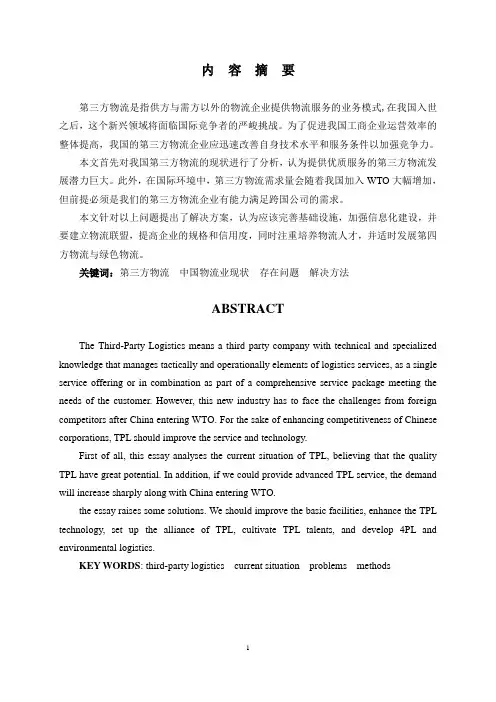
内容摘要第三方物流是指供方与需方以外的物流企业提供物流服务的业务模式,在我国入世之后,这个新兴领域将面临国际竞争者的严峻挑战。
为了促进我国工商企业运营效率的整体提高,我国的第三方物流企业应迅速改善自身技术水平和服务条件以加强竞争力。
本文首先对我国第三方物流的现状进行了分析,认为提供优质服务的第三方物流发展潜力巨大。
此外,在国际环境中,第三方物流需求量会随着我国加入WTO大幅增加,但前提必须是我们的第三方物流企业有能力满足跨国公司的需求。
本文针对以上问题提出了解决方案,认为应该完善基础设施,加强信息化建设,并要建立物流联盟,提高企业的规格和信用度,同时注重培养物流人才,并适时发展第四方物流与绿色物流。
关键词:第三方物流中国物流业现状存在问题解决方法ABSTRACTThe Third-Party Logistics means a third party company with technical and specialized knowledge that manages tactically and operationally elements of logistics services, as a single service offering or in combination as part of a comprehensive service package meeting the needs of the customer. However, this new industry has to face the challenges from foreign competitors after China entering WTO. For the sake of enhancing competitiveness of Chinese corporations, TPL should improve the service and technology.First of all, this essay analyses the current situation of TPL, believing that the quality TPL have great potential. In addition, if we could provide advanced TPL service, the demand will increase sharply along with China entering WTO.the essay raises some solutions. We should improve the basic facilities, enhance the TPL technology, set up the alliance of TPL, cultivate TPL talents, and develop 4PL and environmental logistics.KEY WORDS: third-party logistics current situation problems methods目录一、我国第三方物流的概况 (1)(一)市场需求远期潜力很大,但近期容量很小 (1)(二)物流企业数量很多,但规模较小 (2)(三)中国加入WTO后第三方物流业受到严峻挑战 (2)二、我国第三方物流业遇到的问题及原因分析 (3)(一)第三方物流成本急需降低,技术水平有待提高 (3)(二)服务水平参差不齐,客户满意度低 (4)(三)物流外包行为趋于保守,物流市场需求的结构性不足 (5)(四)我国物流设施重复建设,资源闲置,物流基础环境有待提高 (7)三、我国第三方物流的当务之急和发展方向 (7)(一)完善基础设施,加强信息化建设 (7)(二)建立物流联盟,提高企业的规格和信用度 (8)(三)培养物流人才 (8)(四)切实转变政府职能,彻底打破行政性垄断 (8)(五)健全法律法规,加快发展行业协会组织,创造良好的外部环境 (8)(六)发展第四方物流与绿色物流 (9)参考文献 (10)我国第三方物流存在的问题及改进德国经济学家曾提出,未来只有三种人:生产者,消费者和流通者,可见物流业已经成为影响一切工商业发展的重要领域。
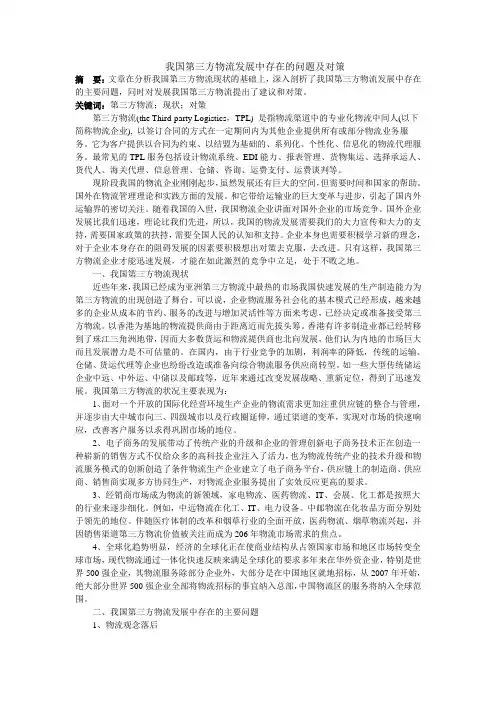
我国第三方物流发展中存在的问题及对策摘要:文章在分析我国第三方物流现状的基础上,深入剖析了我国第三方物流发展中存在的主要问题,同时对发展我国第三方物流提出了建议和对策。
关键词:第三方物流;现状;对策第三方物流(the Third-party Logistics,TPL) 是指物流渠道中的专业化物流中间人(以下简称物流企业), 以签订合同的方式在一定期间内为其他企业提供所有或部分物流业务服务。
它为客户提供以合同为约束、以结盟为基础的、系列化、个性化、信息化的物流代理服务。
最常见的TPL服务包括设计物流系统、EDI能力、报表管理、货物集运、选择承运人、货代人、海关代理、信息管理、仓储、咨询、运费支付、运费谈判等。
现阶段我国的物流企业刚刚起步,虽然发展还有巨大的空间,但需要时间和国家的帮助。
国外在物流管理理论和实践方面的发展。
和它带给运输业的巨大变革与进步,引起了国内外运输界的密切关注。
随着我国的入世,我国物流企业讲面对国外企业的市场竞争。
国外企业发展比我们迅速,理论比我们先进,所以,我国的物流发展需要我们的大力宣传和大力的支持,需要国家政策的扶持,需要全国人民的认知和支持。
企业本身也需要积极学习新的理念,对于企业本身存在的阻碍发展的因素要积极想出对策去克服,去改进。
只有这样,我国第三方物流企业才能迅速发展,才能在如此激烈的竞争中立足,处于不败之地。
一、我国第三方物流现状近些年来,我国已经成为亚洲第三方物流中最热的市场我国快速发展的生产制造能力为第三方物流的出现创造了舞台。
可以说,企业物流服务社会化的基本模式已经形成,越来越多的企业从成本的节约、服务的改进与增加灵活性等方面来考虑,已经决定或准备接受第三方物流。
以香港为基地的物流提供商由于距离近而先拔头筹。
香港有许多制造业都已经转移到了珠江三角洲地带,因而大多数货运和物流提供商也北向发展,他们认为内地的市场巨大而且发展潜力是不可估量的。
在国内,由于行业竞争的加剧,利润率的降低,传统的运输、仓储、货运代理等企业也纷纷改造或准备向综合物流服务供应商转型。
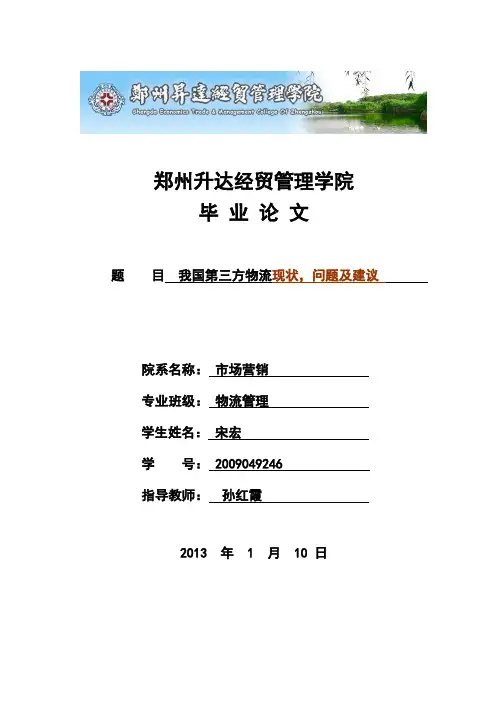
郑州升达经贸管理学院毕业论文题目我国第三方物流现状,问题及建议院系名称:市场营销专业班级:物流管理学生姓名:宋宏学号: 2009049246指导教师:孙红霞2013 年 1 月 10 日我国第三方物流研究摘要众所周知,物流概念引入我国不过二十年,因此本身起步就比较晚,我国第三方物流发展存在经验不足、形成结构不够完善、物流需求不足、观念落后、企业机制不适应、物流人才匮乏、管理水平较低、物流渠道不畅、服务功能不全等等问题。
面对这种情况,我国必须通过转变传统观念,树立物流理念;深化企业改革,实现制度创新;发展增值服务,发展战略同盟关系;以信息技术应用为核心,加快物流人才培养,实施人才战略等等方法来改善我国的第三方物流,使我国的第三方物流与国际物流接轨。
第三方物流作为第三产业的一种服务模式,体现了社会化大生产所需要的规模与效率,以及物流与信息相结合所反映出的巨大价值。
在经济全球化的今天,深入研究第三方物流,对促进我国物流企业跨越式发展,提升企业竞争力,完善社会主义市场经济体制具有重要的现实意义。
关键词:第三方物流,现状,问题分析,发展方向Research on China's The Third party LogisticsAbstractThis thesis, from the macro point of view, anal yzes the third part y logistics in China. Firstl y the concept and content of the third part y logistics are proposed; secondly the thesis investigates the current third part y logistics development in China and puts forward a number of existing problems; finall y some related proposals are addressed.Key Words:the third-part y logistics;current development;anal yzes the problems;Puts forward some proposals目录1.第三方物流概述 (5)1.1第三方物流的定义 (5)1.2 第三方物流的特征 (5)企业关系契约化 (6)需求个性化 (6)服务专业化 (7)管理系统化 (7)信息网络化 (7)2.第三方物流发展的现状 (8)第三方物流的起源 (8)第三方物流的发展 (8)第三方物流的现状 (9)我国第三方物流起步晚 (9)第三方物流企业的结构有待完善 (9)2外资企业对我国第三方物流发展的影响 (10)3.第三方物流发展的主要问题 (11)物流需求不足,观念落后 (11)行业结构不合理 (11)物流人才缺乏,管理水平不高 (11)物流渠道不畅,服务功能不全 (12)4.我国第三方物流发展方向 (12)更新观念,树立物流新理念 (12)加强政府对物流的宏观调控,健全物流业的相关法律机制 .. 13 要着重培养物流人才,实施人才战略 (13)发展增值服务 (13)培育具有国际竞争力的物流集团,实行集约化经营 (14)以信息技术应用为核心,加强网点建设 (14)5.结论 (14)参考文献 (16)第三方物流(The Third part y Logi stics,简称3P L或TPL),是指生产经营企业为集中精力搞好主业,把原来属于自己处理的物流活动,以合同方式委托给专业物流服务企业,同时通过信息系统与物流服务企业保持密切联系,以达到对物流全程的管理和控制的一种物流运作与管理方式。
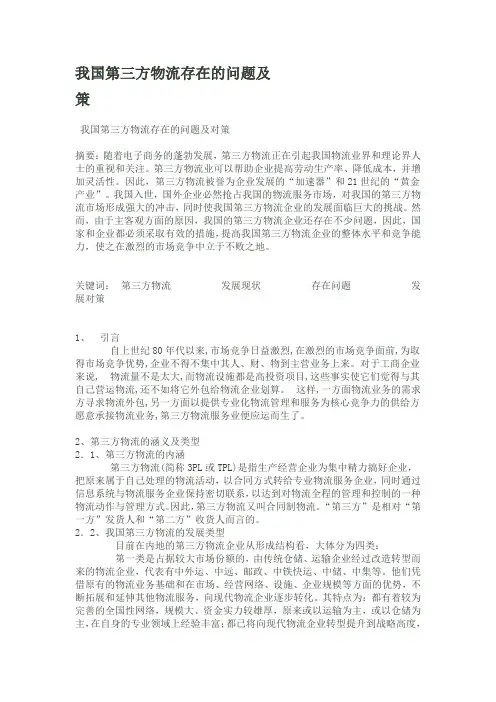
我国第三方物流存在的问题及策我国第三方物流存在的问题及对策摘要:随着电子商务的蓬勃发展,第三方物流正在引起我国物流业界和理论界人士的重视和关注。
第三方物流业可以帮助企业提高劳动生产率、降低成本,并增加灵活性。
因此,第三方物流被誉为企业发展的“加速器”和21世纪的“黄金产业”。
我国入世,国外企业必然抢占我国的物流服务市场,对我国的第三方物流市场形成强大的冲击,同时使我国第三方物流企业的发展面临巨大的挑战。
然而,由于主客观方面的原因,我国的第三方物流企业还存在不少问题,因此,国家和企业都必须采取有效的措施,提高我国第三方物流企业的整体水平和竞争能力,使之在激烈的市场竞争中立于不败之地。
关键词:第三方物流发展现状存在问题发展对策1、引言自上世纪80年代以来,市场竞争日益激烈,在激烈的市场竞争面前,为取得市场竞争优势,企业不得不集中其人、财、物到主营业务上来。
对于工商企业来说, 物流量不是太大,而物流设施都是高投资项目,这些事实使它们觉得与其自己营运物流,还不如将它外包给物流企业划算。
这样,一方面物流业务的需求方寻求物流外包,另一方面以提供专业化物流管理和服务为核心竞争力的供给方愿意承接物流业务,第三方物流服务业便应运而生了。
2、第三方物流的涵义及类型2.1、第三方物流的内涵第三方物流(简称3PL或TPL)是指生产经营企业为集中精力搞好企业,把原来属于自己处理的物流活动,以合同方式转给专业物流服务企业,同时通过信息系统与物流服务企业保持密切联系,以达到对物流全程的管理和控制的一种物流动作与管理方式。
因此,第三方物流又叫合同制物流。
“第三方”是相对“第一方”发货人和“第二方”收货人而言的。
2.2、我国第三方物流的发展类型目前在内地的第三方物流企业从形成结构看,大体分为四类:第一类是占据较大市场份额的,由传统仓储、运输企业经过改造转型而来的物流企业,代表有中外运、中远、邮政、中铁快运、中储、中集等。
他们凭借原有的物流业务基础和在市场、经营网络、设施、企业规模等方面的优势,不断拓展和延伸其他物流服务,向现代物流企业逐步转化。
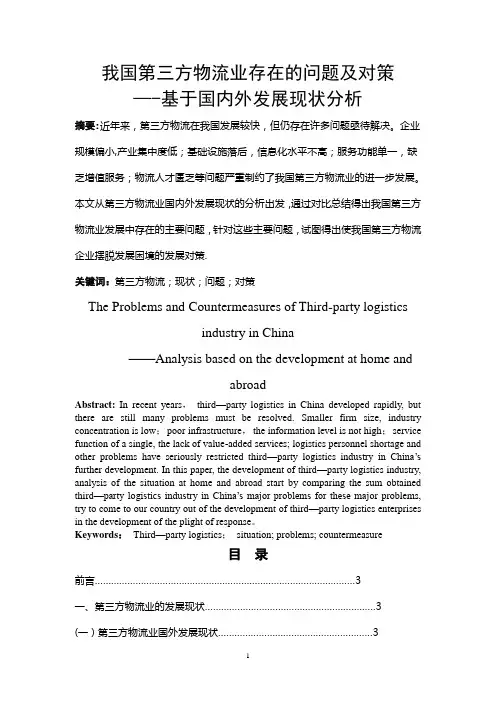
我国第三方物流业存在的问题及对策—-基于国内外发展现状分析摘要:近年来,第三方物流在我国发展较快,但仍存在许多问题亟待解决。
企业规模偏小,产业集中度低;基础设施落后,信息化水平不高;服务功能单一,缺乏增值服务;物流人才匮乏等问题严重制约了我国第三方物流业的进一步发展。
本文从第三方物流业国内外发展现状的分析出发,通过对比总结得出我国第三方物流业发展中存在的主要问题,针对这些主要问题,试图得出使我国第三方物流企业摆脱发展困境的发展对策.关键词:第三方物流;现状;问题;对策The Problems and Countermeasures of Third-party logisticsindustry in China——Analysis based on the development at home andabroadAbstract:In recent years,third—party logistics in China developed rapidly, but there are still many problems must be resolved. Smaller firm size, industry concentration is low;poor infrastructure,the information level is not high;service function of a single, the lack of value-added services; logistics personnel shortage and other problems have seriously restricted third—party logistics in dustry in China’s further development. In this paper, the development of third—party logistics industry, analysis of the situation at home and abroad start by comparing the sum obtained third—party logistics industry in China’s major problems for these maj or problems, try to come to our country out of the development of third—party logistics enterprises in the development of the plight of response。
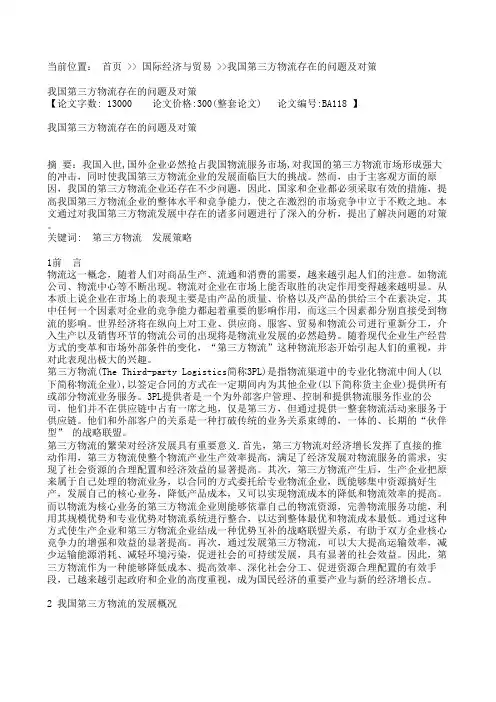
当前位置: 首页 >> 国际经济与贸易 >>我国第三方物流存在的问题及对策我国第三方物流存在的问题及对策【论文字数: 13000 论文价格:300(整套论文) 论文编号:BA118 】我国第三方物流存在的问题及对策摘 要:我国入世,国外企业必然抢占我国物流服务市场,对我国的第三方物流市场形成强大的冲击,同时关键词: 第三方物流 发展策略1前 言物流这一概念,随着人们对商品生产、流通和消费的需要,越来越引起人们的注意。
如物流公司、物流第三方物流(The Third-party Logistics简称3PL)是指物流渠道中的专业化物流中间人(以下简称物流企第三方物流的繁荣对经济发展具有重要意义.首先,第三方物流对经济增长发挥了直接的推动作用,第三2 我国第三方物流的发展概况自从20世纪90年代中期第三方物流开始传到我国以来,随着市场经济体制的完善和企业改革的深入,企2.1 物流基础设施初具规模2003年,国内物流固定资产投资额为5594亿元,占同期全社会固定资产投资额的比例为13.1%。
截至20 2.2 第三方物流需求稳定增长,服务范围不断扩大随着外资企业的进入和市场竞争的加剧,企业对物流重要性的认识逐渐深化,对专业化、多功能的第三2.3第三方物流行业主体稳步发展随着现代物流的快速发展,我国第三方物流业的市场格局发生了很大变化,传统运输和仓储企业的市场3 我国第三方物流存在的问题虽然第三方物流在我国已有了较好的发展,但是,相对于西方物流的发展水平来说,我国的第三方物流3.1 第三方物流存在供求难以对接的问题虽然我国已经出现了一些专业化的第三方物流企业,但物流服务水平和效率还比较低下,企业规模和实力3.2 物流渠道不畅一方面,经营网络不合理,有点无网,第三方物流企业之间、企业与客户之间缺乏合作,货源不足,传在物流领域进一步广泛发展的同时,第三方物流服务必然从传统的劳动密集型向技术密集型转变,必须3.3 自办物流现象突出由于对物流作为“第三利润源泉”的错误认识和受“大而全”、“小而全”的观念影响,很多生产或商3.4 规模偏小论文字数: 13000注:此文版权归本站所有,需付费购买,本站保证购买者的省唯一性。
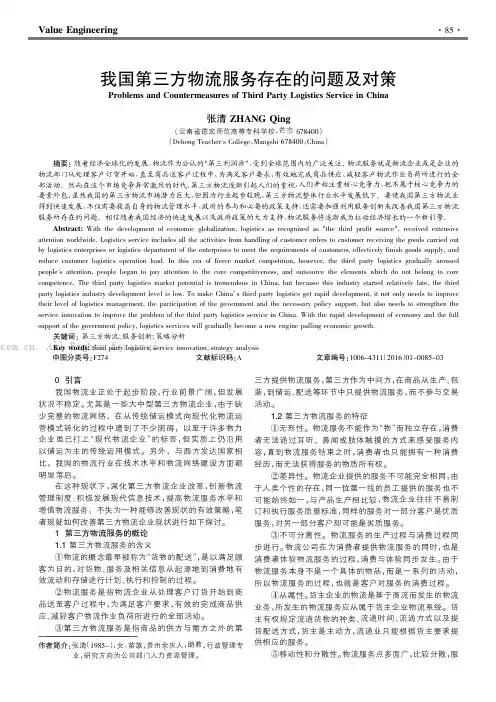
Value Engineering0引言我国物流业正处于起步阶段,行业前景广阔,但发展状况不稳定。
尤其是一些大中型第三方物流企业,由于缺少完整的物流网络,在从传统储运模式向现代化物流运营模式转化的过程中遭到了不少阻碍,以至于许多物力企业虽已打上“现代物流企业”的标签,但实质上仍沿用以储运为主的传统运用模式。
另外,与西方发达国家相比,我国的物流行业在技术水平和物流网络建设方面都明显落后。
在这种现状下,深化第三方物流企业改革,创新物流管理制度;积极发展现代信息技术,提高物流服务水平和增值物流服务,不失为一种能够改善现状的有效策略,笔者现就如何改善第三方物流企业现状进行如下探讨。
1第三方物流服务的概论1.1第三方物流服务的含义①物流的概念最早被称为“货物的配送”,是以满足顾客为目的,对货物、服务及相关信息从起源地到消费地有效流动和存储进行计划、执行和控制的过程。
②物流服务是指物流企业从处理客户订货开始到商品送至客户过程中,为满足客户要求,有效的完成商品供应、减轻客户物流作业负荷所进行的全部活动。
③第三方物流服务是指商品的供方与需方之外的第三方提供物流服务,第三方作为中间方,在商品从生产、包装,到储运、配送等环节中只提供物流服务,而不参与交易活动。
1.2第三方物流服务的特征①无形性。
物流服务不能作为“物”而独立存在,消费者无法通过耳听、鼻闻或肢体触摸的方式来感受服务内容,直到物流服务结束之时,消费者也只能拥有一种消费经历,而无法获得服务的物质所有权。
②差异性。
物流企业提供的服务不可能完全相同,由于人类个性的存在,同一位第一线的员工提供的服务也不可能始终如一,与产品生产相比较,物流企业往往不易制订和执行服务质量标准,同样的服务对一部分客户是优质服务,对另一部分客户却可能是劣质服务。
③不可分离性。
物流服务的生产过程与消费过程同步进行。
物流公司在为消费者提供物流服务的同时,也是消费者体验物流服务的过程,消费与体验同步发生。
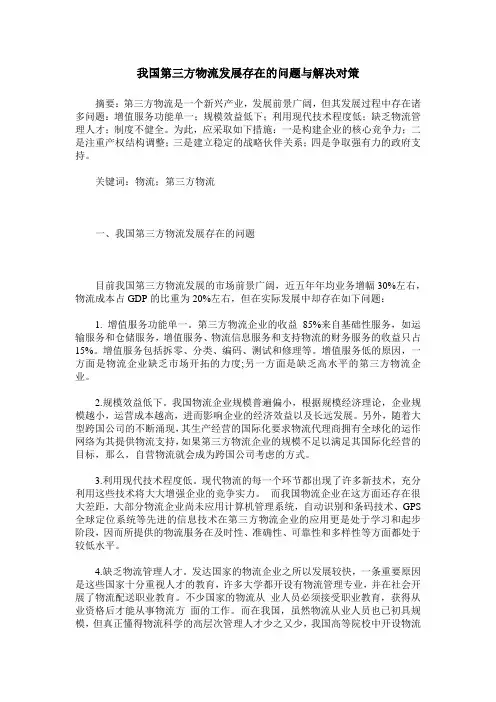
我国第三方物流发展存在的问题与解决对策摘要:第三方物流是一个新兴产业,发展前景广阔,但其发展过程中存在诸多问题:增值服务功能单一;规模效益低下;利用现代技术程度低;缺乏物流管理人才;制度不健全。
为此,应采取如下措施:一是构建企业的核心竞争力;二是注重产权结构调整;三是建立稳定的战略伙伴关系;四是争取强有力的政府支持。
关键词:物流;第三方物流一、我国第三方物流发展存在的问题目前我国第三方物流发展的市场前景广阔,近五年年均业务增幅30%左右,物流成本占GDP的比重为20%左右,但在实际发展中却存在如下问题:1. 增值服务功能单一。
第三方物流企业的收益85%来自基础性服务,如运输服务和仓储服务,增值服务、物流信息服务和支持物流的财务服务的收益只占15%。
增值服务包括拆零、分类、编码、测试和修理等。
增值服务低的原因,一方面是物流企业缺乏市场开拓的力度;另一方面是缺乏高水平的第三方物流企业。
2.规模效益低下。
我国物流企业规模普遍偏小,根据规模经济理论,企业规模越小,运营成本越高,进而影响企业的经济效益以及长远发展。
另外,随着大型跨国公司的不断涌现,其生产经营的国际化要求物流代理商拥有全球化的运作网络为其提供物流支持,如果第三方物流企业的规模不足以满足其国际化经营的目标,那么,自营物流就会成为跨国公司考虑的方式。
3.利用现代技术程度低。
现代物流的每一个环节都出现了许多新技术,充分利用这些技术将大大增强企业的竞争实力。
而我国物流企业在这方面还存在很大差距,大部分物流企业尚未应用计算机管理系统,自动识别和条码技术、GPS 全球定位系统等先进的信息技术在第三方物流企业的应用更是处于学习和起步阶段,因而所提供的物流服务在及时性、准确性、可靠性和多样性等方面都处于较低水平。
4.缺乏物流管理人才。
发达国家的物流企业之所以发展较快,一条重要原因是这些国家十分重视人才的教育,许多大学都开设有物流管理专业,并在社会开展了物流配送职业教育。
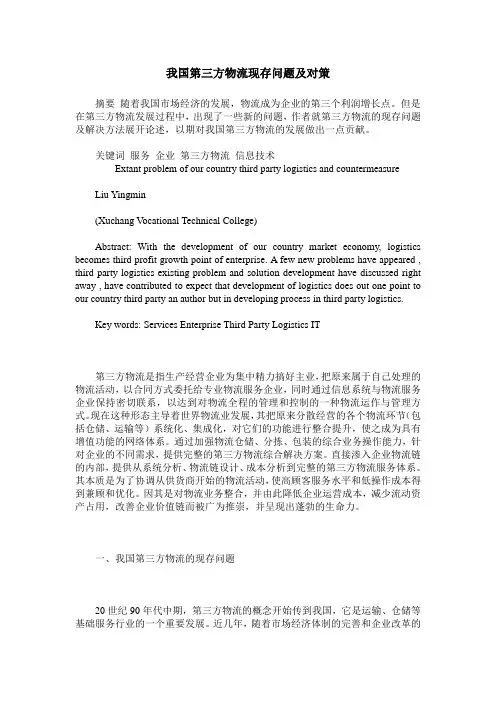
我国第三方物流现存问题及对策摘要随着我国市场经济的发展,物流成为企业的第三个利润增长点。
但是在第三方物流发展过程中,出现了一些新的问题,作者就第三方物流的现存问题及解决方法展开论述,以期对我国第三方物流的发展做出一点贡献。
关键词服务企业第三方物流信息技术Extant problem of our country third party logistics and countermeasureLiu Yingmin(Xuchang V ocational Technical College)Abstract: With the development of our country market economy, logistics becomes third profit growth point of enterprise. A few new problems have appeared , third party logistics existing problem and solution development have discussed right away , have contributed to expect that development of logistics does out one point to our country third party an author but in developing process in third party logistics.Key words: Services Enterprise Third Party Logistics IT第三方物流是指生产经营企业为集中精力搞好主业,把原来属于自己处理的物流活动,以合同方式委托给专业物流服务企业,同时通过信息系统与物流服务企业保持密切联系,以达到对物流全程的管理和控制的一种物流运作与管理方式。
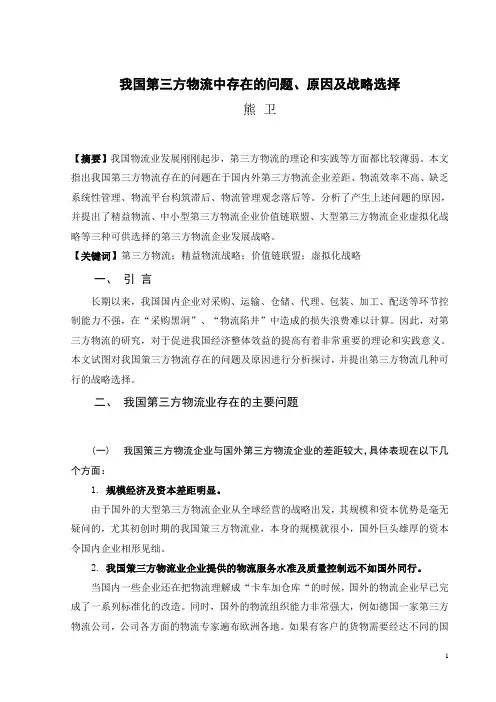
我国第三方物流中存在的问题、原因及战略选择熊卫【摘要】我国物流业发展刚刚起步,第三方物流的理论和实践等方面都比较薄弱。
本文指出我国第三方物流存在的问题在于国内外第三方物流企业差距、物流效率不高、缺乏系统性管理、物流平台构筑滞后、物流管理观念落后等。
分析了产生上述问题的原因,并提出了精益物流、中小型第三方物流企业价值链联盟、大型第三方物流企业虚拟化战略等三种可供选择的第三方物流企业发展战略。
【关键词】第三方物流;精益物流战略;价值链联盟;虚拟化战略一、引言长期以来,我国国内企业对采购、运输、仓储、代理、包装、加工、配送等环节控制能力不强,在“采购黑洞”、“物流陷井”中造成的损失浪费难以计算。
因此,对第三方物流的研究,对于促进我国经济整体效益的提高有着非常重要的理论和实践意义。
本文试图对我国策三方物流存在的问题及原因进行分析探讨,并提出第三方物流几种可行的战略选择。
二、我国第三方物流业存在的主要问题(一)我国策三方物流企业与国外第三方物流企业的差距较大,具体表现在以下几个方面:1.规模经济及资本差距明显。
由于国外的大型第三方物流企业从全球经营的战略出发,其规模和资本优势是毫无疑问的,尤其初创时期的我国策三方物流业,本身的规模就很小,国外巨头雄厚的资本令国内企业相形见绌。
2.我国策三方物流业企业提供的物流服务水准及质量控制远不如国外同行。
当国内一些企业还在把物流理解成“卡车加仓库“的时候,国外的物流企业早已完成了一系列标准化的改造。
同时,国外的物流组织能力非常强大,例如德国一家第三方物流公司,公司各方面的物流专家遍布欧洲各地。
如果有客户的货物需要经达不同的国家,那么欧洲各地的这些专家就在网上设计出一个最佳的物流解决方案。
这种提供解决方案的能力就是这第三方物流公司的核心能力,而不像国内公司号称拥有多少条船,多少辆车。
3.我国加入WTO后物流产业的门槛降低。
在物流服务业方面:我国承诺所有的服务行业,在经过合理过渡期后,取消大部分外国股权限制,不限制外国服务供应商进入目前的市场,不限制所有服务行业的现有市场准入和活动。
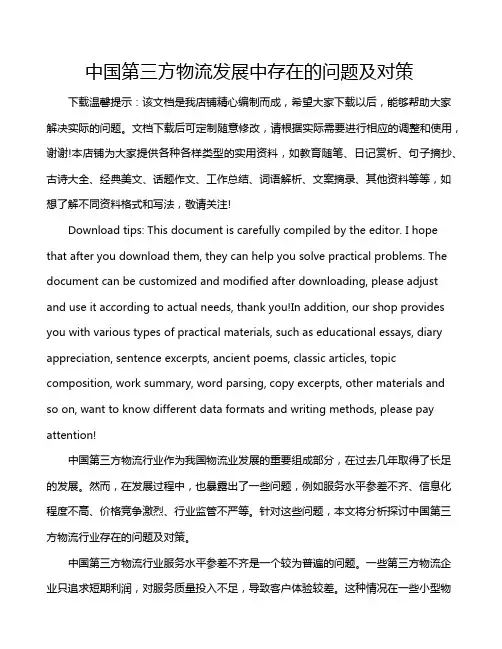
中国第三方物流发展中存在的问题及对策下载温馨提示:该文档是我店铺精心编制而成,希望大家下载以后,能够帮助大家解决实际的问题。
文档下载后可定制随意修改,请根据实际需要进行相应的调整和使用,谢谢!本店铺为大家提供各种各样类型的实用资料,如教育随笔、日记赏析、句子摘抄、古诗大全、经典美文、话题作文、工作总结、词语解析、文案摘录、其他资料等等,如想了解不同资料格式和写法,敬请关注!Download tips: This document is carefully compiled by the editor. I hope that after you download them, they can help you solve practical problems. The document can be customized and modified after downloading, please adjust and use it according to actual needs, thank you!In addition, our shop provides you with various types of practical materials, such as educational essays, diary appreciation, sentence excerpts, ancient poems, classic articles, topic composition, work summary, word parsing, copy excerpts, other materials and so on, want to know different data formats and writing methods, please pay attention!中国第三方物流行业作为我国物流业发展的重要组成部分,在过去几年取得了长足的发展。
本科毕业论文题目我国第三方物流发展现状及对策分析Subject Analysis on Development Situation and Countermeasures of China’s Third PartyLogistics姓名欧阳梅学号010*********所在学院继教(公开)学院年级专业2010级物流管理指导教师封智勇职称讲师完成时间2012 年 3 月12 日我国第三方物流发展现状及对策欧阳梅自考本科物流管理专业(准考证号:010*********)摘要:随着国外物流企业相继进入我国,对物流的研究成为理论界的论点,物流业成为全球一个新的经济增长点。
我国第三方物流的现状体现在企业规模不大,服务水平不高,起步晚、经验少、形成结构不完善等问题。
物流企业必须转变传统观念,深化物流企业改革,实现制度创新,以信息技术应用为核心,加快物流人才培养。
文章从发展现状、制约因素及相关对策等方面对我国第三方物流作出分析,并以此作一个初步的探讨。
关键词:第三方物流;物流发展;对策建议Analysis on Development Situation andCountermeasures of China’s Third PartyLogisticsOu YangMeiAbstract: Along with the foreign logistics enters our country succession,research on logistics theory world as an argument, the logistics industry become a new economic growth point, China's third party logistics present situation manifests as the enterprise size is not big,the service level is not high, late start, with little experience, the formation of structural imperfections problem. Logistics enterprises must change the traditional concepts, deepening the reform of logistics enterprises,realize system innovation,with the application of information technology as the core,to speed up the logistics personnel training. The article from development present situation,restrictive factors and related countermeasures, and other aspects of China's third party logistics to make an analysis, and to make a preliminary exploration£Keywords: Third party logistics;development;countermeasures and suggestions目录前言。
China's third-party logistics problems, causes and strategic choiceXiong WeiAbstract: China's logistics industry has just started, third-party logistics and other aspects of the theory and practice are relatively weak. The paper points out the problems of the Third Party Logistics is the gap between domestic and international third party logistics, logistics efficiency is not high, the lack of systematic management, and logistics platform to build lag behind the concept of logistics management, and so on. Analyzed the causes of such problems arising and proposed lean logistics, small and medium enterprise value chain alliances third party logistics, large third-party logistics companies such as virtualization strategy choice of three third-party logistics enterprise development strategies.Keywords:Third party logistics;lean logistics strategy;value chain alliances; virtualization strategy1. IntroductionFor a long time, China's domestic enterprises procurement, transportation, warehousing, agents, packaging, processing, distribution and other aspects of control is not strong, in the "Procurement black hole", "Logistics trap" in the waste is difficult to calculate losses. Therefore, third-party logistics research, the overall effectiveness in promoting the improvement of China's economy has a very important theoretical and practical significance. This article attempts to my policy of three logistics problems and analysis of the causes of and propose several possible third-party logistics strategic choice.2 Third party logistics industry in China's major problems(A) The national policy of three logistics companies and foreign big gap between third-party logistics companies, specifically in the following areas:1, economies of scale and capital gap significantly. Because third-party logistics companies large foreign strategic departure from the global business, its advantages of scale and capital is no doubt, especially start-up period of three logistics policy I, its very small size, strongcapital that foreign giants China enterprises to shame.2, I state policy of the logistics enterprises provide three logistics service level and quality control rather than foreign counterparts. When some domestic enterprise is still in logistics interpreted as "trucks, add warehouse logistics enterprises abroad already completed a series of standardized transformation. Meanwhile, foreign logistics organizational ability so powerful, Germany, for example, a third-party logistics company, all aspects of logistics experts across all over Europe. If the goods by a customer needs of different countries, so these experts from all over Europe in online design a the best logistics solutions. This provides solutions is the ability that the core competence of third-party logistics companies, unlike domestic companies claim to having many ship, how many car.3, China's accession to WTO, lower the threshold of the logistics industry. The logistics service industry: our commitment to all of the services sector, after a reasonable transition period, to cancel most of the foreign equity limit does not restrict access to foreign service providers the current market, do not restrict all the service sectors and the existing market access activities. The secondary distribution services while also making a similar commitment. These restrictions will be phased out after 3-4 years, during which foreign service providers can create a hundred per cent wholly-owned subsidiaries or business sector, the domestic logistics industry will face international competition.(B) serious waste of resources, third party logistics efficiency is not high. From the microscopic point of view, due to the impact of the planned economy, a long time many enterprises, especially state-owned enterprises to go the "large", "small" route, they have their own warehouse, fleet, and even ocean-going vessels team, resulting in wasting a lot of the logistics process, the specific performance of the idle warehouse, logistics decentralized operation, the low level of organization, transverse joint weak. And to provide integrated, modern, professional, punctual, efficient services to third-party logistics enterprises are very small. From a macro point of view of economic development of third-party logistics failed to keep up with the pace of the formation of industrial management model, but only with the transportation, telecommunications, commercial materials, foreign trade and other sectors of the integration and collaboration.(C) the lack of systematic management, equipment standardization is low. Most of the current third-party logistics enterprises in China under the traditional system based on materials circulation enterprises developed, the service mainly stay in the storage, transportation, lack of systematic management, logistics, low efficiency, lack of effective third party logistics functions Play. In addition, the fragmentation of China's logistics sector, making the link in the transportation logistics and equipment standards are not uniform, does not support current standards for physical facilities, resulting in the increase in third-party logistics invalid operation, speed, and reduce costs.(D) third-party logistics platform to build lag, lower degree of information technology. Third-party logistics and distribution platforms, including physical network and information network, physical network refers to the logistics facilities, transportation, transportation hubs in the geographical location of the rational distribution and the formation of physical network; information networks that use third-party logistics business and information technology, Information resources to their chain integration and the formation of a shared network of information resources. The status of physical network are: low levels of third-party logistics and equipment, and information networks also lack the necessary public logistics platform. (E) the concept of logistics management of domestic enterprises is still very backward, which greatly restricts the development of third party logistics. For example: Some companies believe that inventory information is confidential business information must be managed by the enterprises themselves, the class of business activities while outsourcing the management concept difficult to accept, often resulting in control of their own poor management of logistics, business competition in the market weakens Force.3 Causes of problems analysis(A) lack of modern logistics management knowledge and expertise of logistics personnel. This is the third-party logistics industry in restricting the development of China's most important one of the bottlenecks. Logistics knowledge, especially in modern integrated third party logistics knowledge is far from being universal, but that its main business areas is to provide transportation and warehousing services, not know that it is new to these traditional business integration of its business fields Far too simple to become connected with transportand storage of raw materials, semi-finished products supply, production process, material flow, the whole process of product distribution services, as cover flow, solid logistics, capital flow, information flow is equal to the integrated system of systems.(B) fails to effectively use modern technology. This situation has greatly restricted the cultivation of third-party logistics companies, affecting their overall competitive strength increased. China's accession to the WTO, domestic enterprises will face third-party logistics strong competition from abroad, the domestic third-party logistics industry is difficult to provide low-cost, high quality and efficient service.(C) subject to the constraints of traditional management systems. Fragmentation in the traditional institutional arrangements, third party logistics activities have been separated from many different sectors such as transportation, post and telecommunications, foreign trade, domestic trade and only involves the transport industry to the Ministry of Railways, Ministry of Communications, etc. Some departments, the lack of efficient collaboration between departments, resulting in the transport process of rotation of the mode of transport and time-consuming part of the cost of logistics in the process of becoming "trap. " There are also procedures for customs management, material procurement and other aspects of some of the provisions of the logistics enterprises also raise the level of integrated services and business development areas, thus restricting the rapid development of third-party logistics industry.4 The third party logistics enterprise strategic choice Summarized the latest of several foreign logistics theory and the development of third-party logistics with the current practice of foreign, third-party logistics firm's strategic choice to have the following three:(A)Lean Logistics StrategySince the lag theory and practice of logistics, our most extensive third-party logistics company or business, it can not accurately position their logistics services. If you do not reverse this situation as soon as possible, will be third-party logistics industry in China have restricted role. Lean production theory of logistics for our third-party logistics company provides a new development ideas for these enterprises to survive in the new economy and development opportunities. Lean Logistics concept originated in lean manufacturing. It isproduced from the Toyota Motor Corporation 70 years in the last century by the original "Toyota Production System", after research by the Massachusetts Institute of Technology professor and summary, was published in 1990 published "change the world of machines), a book. Lean thinking is the use of various modern management methods and means, based on the needs of society to fully play the role of people as a fundamental and effective allocation and rational use of corporate resources to maximize economic benefits for enterprises to seek a new Management philosophy. Lean Logistics Lean Thinking is the application in logistics management, logistics development must reflect. The so-called Lean Logistics means: the process by eliminating the production and supply of non-value added waste in order to reduce stocking time, improve customer satisfaction. The aim of Lean Logistics according to customer needs, providing customers with logistics services, while pursuing the provision of logistics services in the process to minimize waste and delay, the process of increasing value added logistics services. Lean logistics system is characterized by its high-quality, low cost, continuous improvement, driven by customer demand oriented logistics system. It requires establishing the customer first thought, on time, accurate and fast delivery of goods and information.In short, Lean Logistics, as a new management ideas, bound to have a third-party logistics enterprises in China have far-reaching impact, it will change the appearance of the extensive third party logistics management concept, the formation of third party logistics Core competitiveness.(B)the establishment of small and medium third party logistics value chain allianceThird-party logistics enterprises of small and medium can not be independent because of their one-stop logistics services to provide full shortcomings, and because the small size of assets, services, not wide area so that small and medium enterprises in China's logistics third party logistics industry at a disadvantage. Therefore, third party logistics for small and medium enterprises, starting from their own resources to construct their own core competence is the key. As small and medium enterprise features of a single third-party logistics and incomplete, so based on their respective core competencies based on the structure of the logistics business enterprise cooperation is an effective capacity to make up for deficiencies,constitutes a feasible way of competitive advantage of logistics. Value chain is the use of systems approach to investigate the interaction between business and the analysis of all activities and their access to the resources of competitive advantage. Value of the business activities fall into two categories: basic activities and support activities. Basic activities are involved in product creation and sale of the material transferred to the buyer and after-sales service activities. Basic activities of supporting activities is to assist the revenue by providing outsourcing, technology, human resources and a variety of functions to support each other. Theory to analyze the value chain study the value of third party logistics chain composition, can be found in auxiliary activities, third party logistics enterprise and general business is no different, the basic activities in the third-party logistics companies has its own characteristics. Third-party logistics enterprises there is generally no commodity production process, only the re-circulation process, does not account for major components of a wide range of third-party logistics companies and thus become the basic operating activities of storage, transport, packaging, distribution, customer service and marketing, etc. link. Various aspects of the basic work activities, due to their own limited resources and capacity, can not have every aspect of an advantage in that value chain in terms of some of the deficiencies, resulting in their overall logistics function not complete, lack of corresponding competitiveness and comparative advantage in some sectors of the value chain due to lack of overall effect should not play. Therefore, third party logistics industry, small and medium sized logistics enterprises within the Union, should be based on the value chain between complementary on the basis of cooperation, make full use of professional logistics companies and logistics functions of specialized logistics organization and coordination of agents Flexible complementary integrated logistics capabilities. Third-party logistics for small and medium enterprises, value chain should start with the advantage of links to explore and develop the core competitiveness of enterprises, through the reconstruction of the value chain to avoid weaknesses.(C)Large third-party logistics enterprise virtualization of strategyRapid development in IT and the Internet era, companies can not fight alone singles, but must be in the competition and collaboration, in cooperation and development. Thus, under modern conditions resulting from modern large-scale virtualized development of third-partylogistics has a strong necessity. Large third-party logistics enterprise virtualization is the logistics management resources of others who will have "all", through the network, the other part into its own logistics, with the help of others break the power of physical boundaries, extending to achieve their various Function, and thus expand their ability to enhance their strength. Therefore, the logistics information technology, virtualization is a means for the connection and coordination of temporary and dynamic alliance in the form of virtual logistics. Integrated logistics virtualization technology as a means of electronic communication, customer-focused, based on the opportunity to participate in members of the core competencies as a condition to an agreement for the common pursuit of goals and tasks, the different parts of the country's existing Resources to quickly mix into a no walls, beyond the space constraints, by means of electronic networks, contact the unified command of the virtual business entity, the fastest launch of high-quality, low-cost logistics service.Modern large-scale virtualization, including third-party logistics functions, organization, geographic three virtualization. Virtualization capabilities with third-party logistics enterprise IT technology will be distributed in different locations, different companies take different functions within the logistics resources (information, human, material and other resources) organized to accomplish a specific task, to achieve the optimization of social resources. Virtualization refers to the organizational structure of the logistics organization is always dynamically adjusted, not fixed, but also decentralized, flexible, self-management, flat network structure, its objectives and in accordance with changes in the environment re-combination, in a timely manner Reflect the market dynamics. Virtual is the regional third party logistics network through the Internet link the global logistics resources, removing barriers and national barriers, to production management to achieve "virtual neighbors. "我国第三方物流中存在的问题、原因及战略选择熊卫【摘要】我国物流业发展刚刚起步,第三方物流的理论和实践等方面都比较薄弱。
我国第三方物流存在的问题及发展我国第三方物流存在的问题及发展_军事/政治_人文社科_专业资料暂无评价|0人阅读|0次下载政治_人文社科_专业资料。
我国第三方物流存在的问题及发展我国第三方物流存在的问题及对策一.引言在当今世界经济迅猛发展、市场竞争激化和社会分工进一步细化的形势下。
有些商家开始意识到自己并不是运输经营和库存管理的行家。
为了把更多的精力集中于自己的主营业务上,以便同自己的对手展开竞争,有些厂商开始把一些自己不十分在行的,诸如运输、仓储这样的业务外包给“第三方”经营。
有需求就会有供给,这是市场经济的基本规律。
为了满足工商企业的日益增加的物流需求,第三方物流应运而生,并迅速成为一种潮流和趋势。
第三方物流在其他国家市场占有率德国市场占有率23.33% 美国 57% 日本 80% 二.寻根探源,第三方物流的概念及特点第三方物流兴起于 20 世纪 80 年代后期的美国。
在 1988 年美国物流管员会的一项顾客服务调查中,首次提出“第三方服务提供者”一词②。
第三方物流(Third party Logistics,3PL 或 TPL)在我国《物流术语》中的定义:“供方与需方以外的物流企业提供物流服务的模式①。
” 也就是说,物流企业向供方和需方提供的是一种以运输、储存为主的,搬运、包装、流通加工、配送、信息处理等多种功能相结合的服务活动。
第三方物流主要有几个方面的特点,一是多功能、全方位的服务,不像运输公司和仓储公司那样只提供运输或仓储单项服务。
二是个性化的服务,物流的服务对象一般都较少,只是一家或数家,服务时间却较长,往往长达几年。
三是联盟关系的服务,物流服务必须依靠现代信息技术的支撑,第三方物流企业与委托方之间要充分共享信息,这就要求双方相互信任合作,在行为上要通过契约结成优势互补、风险共担的伙伴,因此,第三方物流企业与委托方企业之间是物流联盟关系三.迅速崛起,第三方物流在我国的繁荣发展第三方物流概念从二十世纪 90 年代进入我国,短短几年的时间里在国内掀起了一股“第三方物流热”。
我国第三方物流现状及存在问题分析一、概述随着全球经济一体化的加速推进,物流行业作为连接生产、流通和消费的桥梁,其地位和作用日益凸显。
在我国,第三方物流作为物流行业的重要组成部分,近年来得到了快速发展,但同时也暴露出一些问题。
本文旨在通过对我国第三方物流现状及存在问题的深入分析,为行业的健康、可持续发展提供借鉴和参考。
第三方物流,又称合同物流或外包物流,是指企业将其全部或部分物流业务外包给专业的物流服务提供商,以降低成本、提高效率、优化资源配置。
在我国,第三方物流市场发展迅速,市场规模不断扩大,服务水平也在逐步提升。
与发达国家相比,我国第三方物流行业在管理理念、技术应用、服务质量和市场规范等方面仍存在一定差距。
当前,我国第三方物流行业面临着激烈的市场竞争和不断变化的客户需求。
企业要想在市场中立足,就必须不断提高自身的核心竞争力,加强内部管理,提升服务质量。
同时,政府也应加强对行业的监管和引导,推动行业向规范化、标准化方向发展。
本文将从多个角度对我国第三方物流现状及存在的问题进行深入剖析,并提出相应的改进措施和建议,以期为我国第三方物流行业的健康发展提供有益的参考和借鉴。
1. 第三方物流的定义与发展背景第三方物流,作为现代物流服务的一种重要形式,是指独立于供方和需方的第三方企业,通过合同方式,提供包括仓储、运输、配送等一系列物流服务,以满足客户的物流需求。
这种物流形态既不拥有商品,也不参与商品的买卖,而是专注于为客户提供专业化、个性化的物流解决方案。
在我国,第三方物流的发展背景具有鲜明的时代特征。
随着国民经济的持续高速发展,物流需求日益旺盛,传统的第一方和第二方物流已无法满足日益增长的市场需求。
改革开放的深入推进和市场竞争的加剧,也促使企业更加注重核心竞争力的培养,将非核心业务的物流活动外包出去,从而专注于自身的核心业务。
信息技术的快速发展也为第三方物流的崛起提供了有力支撑。
通过应用先进的物流信息技术,如物联网、大数据、人工智能等,第三方物流企业能够实现对物流流程的精准掌控和优化,提高物流运作的效率和准确性,降低物流成本,为客户提供更加优质的服务体验。
我国第三方物流发展中存在的问题及对策我国第三方物流发展中存在的问题主要包括以下几个方面:1. 缺乏专业人才:虽然有很多大学生参加物流公司的招聘,但很少有人具备实践经验和专业知识。
同时,由于物流行业工作相对辛苦,很多员工不愿意从事这类工作。
这种状况导致物流企业愈发集中在初级和基础工作,而对专业性的需求长期得不到重视,更高端人才更是缺乏。
2. 能力与信息不对称:许多企业缺乏正确的经营策略和管理思维,不了解国内物流市场的现状与发展趋势。
同时,物流企业之间存在着能力和信息的不对称。
大企业通过收购、兼并等方式实现了规模化发展优势,进而实现了对市场的顶层设计。
而中小企业因缺乏能力,在市场竞争中处于劣势。
3. 单向货流与网络不稳定:第三方物流中,货品流向是客户出产、销售的流向,除了少量逆向物流,货品的流向是不可逆的。
第三方物流企业的网络都是依据客户的事务拓展而来的。
就单条线路而言,整条线路都是服务于单个大客户的,线路上的货量跟客户的销量息息相关,导致线路货量的稳定性无法获得保障。
4. 网络渠道兴起与货量空间紧缩:随着渠道成为最大的资源整合体,第三方物流存在的意义将被渠道所替代。
同时,恶性竞争导致第三方物流企业的毛利率不断下降。
针对以上问题,可以采取以下对策:1. 建立完善的职业培训机制:企业需要注重内部培训,增加员工的专业技能和知识。
建立稳定的员工提升渠道,为员工提供发展机会和广阔的职业路线。
2. 制定正确的经营策略和管理思维:企业需要了解国内物流市场的现状与发展趋势,制定正确的经营策略和管理思维。
3. 优化运力规划能力:针对网络不稳定的问题,企业需要优化运力规划能力,提高线路货量的稳定性。
4. 寻求新的发展模式:面对网络渠道的兴起和货量空间的紧缩,第三方物流企业可以寻求新的发展模式,如与电商企业合作、开展跨境电商等,以拓展业务范围和渠道。
5. 提高服务质量:通过提高服务质量,第三方物流企业可以增强自身的竞争力,赢得客户的信任和忠诚度。
China's third-party logistics problems, causes and strategic choiceXiong WeiAbstract: China's logistics industry has just started, third-party logistics and other aspects of the theory and practice are relatively weak. The paper points out the problems of the Third Party Logistics is the gap between domestic and international third party logistics, logistics efficiency is not high, the lack of systematic management, and logistics platform to build lag behind the concept of logistics management, and so on. Analyzed the causes of such problems arising and proposed lean logistics, small and medium enterprise value chain alliances third party logistics, large third-party logistics companies such as virtualization strategy choice of three third-party logistics enterprise development strategies.Keywords:Third party logistics;lean logistics strategy;value chain alliances; virtualization strategy1. IntroductionFor a long time, China's domestic enterprises procurement, transportation, warehousing, agents, packaging, processing, distribution and other aspects of control is not strong, in the "Procurement black hole", "Logistics trap" in the waste is difficult to calculate losses. Therefore, third-party logistics research, the overall effectiveness in promoting the improvement of China's economy has a very important theoretical and practical significance. This article attempts to my policy of three logistics problems and analysis of the causes of and propose several possible third-party logistics strategic choice.2 Third party logistics industry in China's major problems(A) The national policy of three logistics companies and foreign big gap between third-party logistics companies, specifically in the following areas:1, economies of scale and capital gap significantly. Because third-party logistics companies large foreign strategic departure from the global business, its advantages of scale and capital is no doubt, especially start-up period of three logistics policy I, its very small size, strongcapital that foreign giants China enterprises to shame.2, I state policy of the logistics enterprises provide three logistics service level and quality control rather than foreign counterparts. When some domestic enterprise is still in logistics interpreted as "trucks, add warehouse logistics enterprises abroad already completed a series of standardized transformation. Meanwhile, foreign logistics organizational ability so powerful, Germany, for example, a third-party logistics company, all aspects of logistics experts across all over Europe. If the goods by a customer needs of different countries, so these experts from all over Europe in online design a the best logistics solutions. This provides solutions is the ability that the core competence of third-party logistics companies, unlike domestic companies claim to having many ship, how many car.3, China's accession to WTO, lower the threshold of the logistics industry. The logistics service industry: our commitment to all of the services sector, after a reasonable transition period, to cancel most of the foreign equity limit does not restrict access to foreign service providers the current market, do not restrict all the service sectors and the existing market access activities. The secondary distribution services while also making a similar commitment. These restrictions will be phased out after 3-4 years, during which foreign service providers can create a hundred per cent wholly-owned subsidiaries or business sector, the domestic logistics industry will face international competition.(B) serious waste of resources, third party logistics efficiency is not high. From the microscopic point of view, due to the impact of the planned economy, a long time many enterprises, especially state-owned enterprises to go the "large", "small" route, they have their own warehouse, fleet, and even ocean-going vessels team, resulting in wasting a lot of the logistics process, the specific performance of the idle warehouse, logistics decentralized operation, the low level of organization, transverse joint weak. And to provide integrated, modern, professional, punctual, efficient services to third-party logistics enterprises are very small. From a macro point of view of economic development of third-party logistics failed to keep up with the pace of the formation of industrial management model, but only with the transportation, telecommunications, commercial materials, foreign trade and other sectors of the integration and collaboration.(C) the lack of systematic management, equipment standardization is low. Most of the current third-party logistics enterprises in China under the traditional system based on materials circulation enterprises developed, the service mainly stay in the storage, transportation, lack of systematic management, logistics, low efficiency, lack of effective third party logistics functions Play. In addition, the fragmentation of China's logistics sector, making the link in the transportation logistics and equipment standards are not uniform, does not support current standards for physical facilities, resulting in the increase in third-party logistics invalid operation, speed, and reduce costs.(D) third-party logistics platform to build lag, lower degree of information technology. Third-party logistics and distribution platforms, including physical network and information network, physical network refers to the logistics facilities, transportation, transportation hubs in the geographical location of the rational distribution and the formation of physical network; information networks that use third-party logistics business and information technology, Information resources to their chain integration and the formation of a shared network of information resources. The status of physical network are: low levels of third-party logistics and equipment, and information networks also lack the necessary public logistics platform. (E) the concept of logistics management of domestic enterprises is still very backward, which greatly restricts the development of third party logistics. For example: Some companies believe that inventory information is confidential business information must be managed by the enterprises themselves, the class of business activities while outsourcing the management concept difficult to accept, often resulting in control of their own poor management of logistics, business competition in the market weakens Force.3 Causes of problems analysis(A) lack of modern logistics management knowledge and expertise of logistics personnel. This is the third-party logistics industry in restricting the development of China's most important one of the bottlenecks. Logistics knowledge, especially in modern integrated third party logistics knowledge is far from being universal, but that its main business areas is to provide transportation and warehousing services, not know that it is new to these traditional business integration of its business fields Far too simple to become connected with transportand storage of raw materials, semi-finished products supply, production process, material flow, the whole process of product distribution services, as cover flow, solid logistics, capital flow, information flow is equal to the integrated system of systems.(B) fails to effectively use modern technology. This situation has greatly restricted the cultivation of third-party logistics companies, affecting their overall competitive strength increased. China's accession to the WTO, domestic enterprises will face third-party logistics strong competition from abroad, the domestic third-party logistics industry is difficult to provide low-cost, high quality and efficient service.(C) subject to the constraints of traditional management systems. Fragmentation in the traditional institutional arrangements, third party logistics activities have been separated from many different sectors such as transportation, post and telecommunications, foreign trade, domestic trade and only involves the transport industry to the Ministry of Railways, Ministry of Communications, etc. Some departments, the lack of efficient collaboration between departments, resulting in the transport process of rotation of the mode of transport and time-consuming part of the cost of logistics in the process of becoming "trap. " There are also procedures for customs management, material procurement and other aspects of some of the provisions of the logistics enterprises also raise the level of integrated services and business development areas, thus restricting the rapid development of third-party logistics industry.4 The third party logistics enterprise strategic choice Summarized the latest of several foreign logistics theory and the development of third-party logistics with the current practice of foreign, third-party logistics firm's strategic choice to have the following three:(A)Lean Logistics StrategySince the lag theory and practice of logistics, our most extensive third-party logistics company or business, it can not accurately position their logistics services. If you do not reverse this situation as soon as possible, will be third-party logistics industry in China have restricted role. Lean production theory of logistics for our third-party logistics company provides a new development ideas for these enterprises to survive in the new economy and development opportunities. Lean Logistics concept originated in lean manufacturing. It isproduced from the Toyota Motor Corporation 70 years in the last century by the original "Toyota Production System", after research by the Massachusetts Institute of Technology professor and summary, was published in 1990 published "change the world of machines), a book. Lean thinking is the use of various modern management methods and means, based on the needs of society to fully play the role of people as a fundamental and effective allocation and rational use of corporate resources to maximize economic benefits for enterprises to seek a new Management philosophy. Lean Logistics Lean Thinking is the application in logistics management, logistics development must reflect. The so-called Lean Logistics means: the process by eliminating the production and supply of non-value added waste in order to reduce stocking time, improve customer satisfaction. The aim of Lean Logistics according to customer needs, providing customers with logistics services, while pursuing the provision of logistics services in the process to minimize waste and delay, the process of increasing value added logistics services. Lean logistics system is characterized by its high-quality, low cost, continuous improvement, driven by customer demand oriented logistics system. It requires establishing the customer first thought, on time, accurate and fast delivery of goods and information.In short, Lean Logistics, as a new management ideas, bound to have a third-party logistics enterprises in China have far-reaching impact, it will change the appearance of the extensive third party logistics management concept, the formation of third party logistics Core competitiveness.(B)the establishment of small and medium third party logistics value chain allianceThird-party logistics enterprises of small and medium can not be independent because of their one-stop logistics services to provide full shortcomings, and because the small size of assets, services, not wide area so that small and medium enterprises in China's logistics third party logistics industry at a disadvantage. Therefore, third party logistics for small and medium enterprises, starting from their own resources to construct their own core competence is the key. As small and medium enterprise features of a single third-party logistics and incomplete, so based on their respective core competencies based on the structure of the logistics business enterprise cooperation is an effective capacity to make up for deficiencies,constitutes a feasible way of competitive advantage of logistics. Value chain is the use of systems approach to investigate the interaction between business and the analysis of all activities and their access to the resources of competitive advantage. Value of the business activities fall into two categories: basic activities and support activities. Basic activities are involved in product creation and sale of the material transferred to the buyer and after-sales service activities. Basic activities of supporting activities is to assist the revenue by providing outsourcing, technology, human resources and a variety of functions to support each other. Theory to analyze the value chain study the value of third party logistics chain composition, can be found in auxiliary activities, third party logistics enterprise and general business is no different, the basic activities in the third-party logistics companies has its own characteristics. Third-party logistics enterprises there is generally no commodity production process, only the re-circulation process, does not account for major components of a wide range of third-party logistics companies and thus become the basic operating activities of storage, transport, packaging, distribution, customer service and marketing, etc. link. Various aspects of the basic work activities, due to their own limited resources and capacity, can not have every aspect of an advantage in that value chain in terms of some of the deficiencies, resulting in their overall logistics function not complete, lack of corresponding competitiveness and comparative advantage in some sectors of the value chain due to lack of overall effect should not play. Therefore, third party logistics industry, small and medium sized logistics enterprises within the Union, should be based on the value chain between complementary on the basis of cooperation, make full use of professional logistics companies and logistics functions of specialized logistics organization and coordination of agents Flexible complementary integrated logistics capabilities. Third-party logistics for small and medium enterprises, value chain should start with the advantage of links to explore and develop the core competitiveness of enterprises, through the reconstruction of the value chain to avoid weaknesses.(C)Large third-party logistics enterprise virtualization of strategyRapid development in IT and the Internet era, companies can not fight alone singles, but must be in the competition and collaboration, in cooperation and development. Thus, under modern conditions resulting from modern large-scale virtualized development of third-partylogistics has a strong necessity. Large third-party logistics enterprise virtualization is the logistics management resources of others who will have "all", through the network, the other part into its own logistics, with the help of others break the power of physical boundaries, extending to achieve their various Function, and thus expand their ability to enhance their strength. Therefore, the logistics information technology, virtualization is a means for the connection and coordination of temporary and dynamic alliance in the form of virtual logistics. Integrated logistics virtualization technology as a means of electronic communication, customer-focused, based on the opportunity to participate in members of the core competencies as a condition to an agreement for the common pursuit of goals and tasks, the different parts of the country's existing Resources to quickly mix into a no walls, beyond the space constraints, by means of electronic networks, contact the unified command of the virtual business entity, the fastest launch of high-quality, low-cost logistics service.Modern large-scale virtualization, including third-party logistics functions, organization, geographic three virtualization. Virtualization capabilities with third-party logistics enterprise IT technology will be distributed in different locations, different companies take different functions within the logistics resources (information, human, material and other resources) organized to accomplish a specific task, to achieve the optimization of social resources. Virtualization refers to the organizational structure of the logistics organization is always dynamically adjusted, not fixed, but also decentralized, flexible, self-management, flat network structure, its objectives and in accordance with changes in the environment re-combination, in a timely manner Reflect the market dynamics. Virtual is the regional third party logistics network through the Internet link the global logistics resources, removing barriers and national barriers, to production management to achieve "virtual neighbors. "我国第三方物流中存在的问题、原因及战略选择熊卫【摘要】我国物流业发展刚刚起步,第三方物流的理论和实践等方面都比较薄弱。